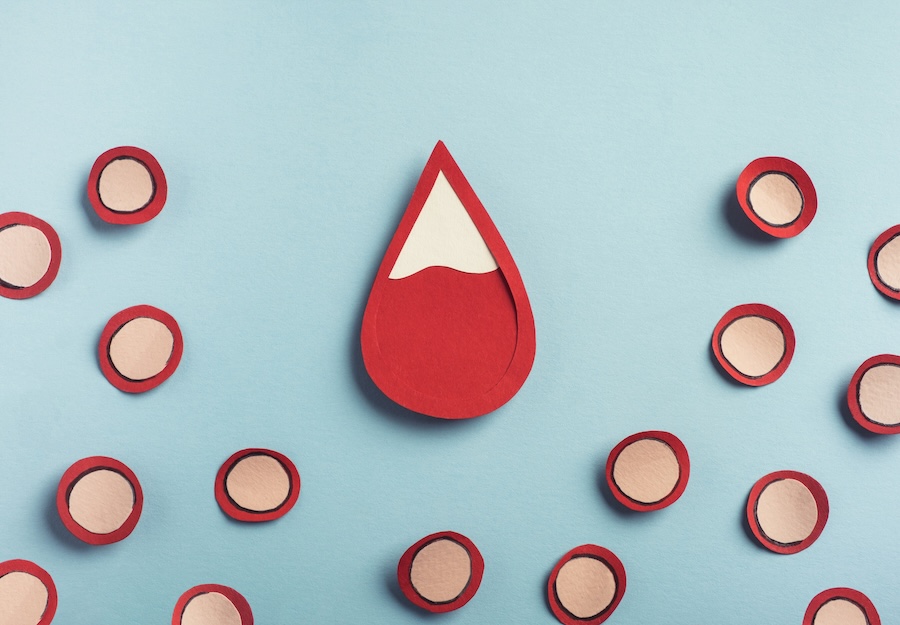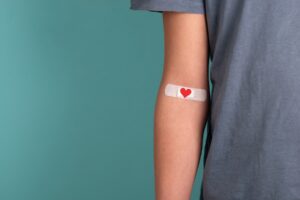
Project Summary: Iron Deficiency
Iron deficiency and anemia are commonly diagnosed and can result in significant negative health impacts if not treated. Intravenous iron offers a rapid treatment option that is often superior to oral iron.
Looking for an infusion center? Check this infusion center website locator.
- Iron deficiency anemia is the most common blood problem in the world.
- Iron deficiency can result in anemia, in which not enough red blood cells are available to carry oxygen throughout the body.
- Symptoms include feeling tired, weak or dizzy and having pale skin, cold hands and feet. Other symptoms include headache, swollen legs, restless leg syndrome, and dry or brittle hair and nails. Occasionally, it can cause chest pain, a fast heartbeat and shortness of breath.
- The first line of treatment for low iron levels and anemia is usually oral iron tablets.
- Oral iron supplements are often discontinued due to side effects, including gastrointestinal issues. This is especially problematic for individuals suffering from inflammatory bowel disease.
- In some cases, oral iron supplementation does not increase iron levels or reduce anemia.
- Medical guidelines for the treatment of iron deficiency anemia are outdated in many countries.
- The Parsemus Foundation provides evidence-based information on better treatment options for common ailments.
- Intravenous iron infusion offers a rapid recovery from iron deficiency and anemia, often with only one or two treatments.
- Intravenous iron is preferred over oral iron supplements to replace iron in iron deficient individuals with chronic inflammatory conditions or when oral therapy is poorly tolerated or ineffective.
Project Topics
Intravenous iron quickly cures anemia
For individuals suffering from iron deficiency anemia, the most common treatment is oral iron supplements. However, intravenous iron allows complete replacement of iron and alleviation of anemia in one (or more) sessions. With the development of safer solutions, IV iron has been used more often for anemic individuals with inflammatory bowel disease, gynecological and obstetric issues, renal failure, and cancer. Yet it is still an underutilized method due to outdated methods and safety concerns. IV iron may be particularly helpful for older individuals, who may not even realize that they have iron deficiency.
Iron deficiency anemia is the most common nutritional deficiency worldwide
Anemia indicates that you don’t have enough healthy red blood cells to carry adequate oxygen to your body’s tissues. Iron deficiency is the most common cause of anemia worldwide, affecting approximately 27% of the world’s population. It is more common in developing countries.
It is important to note that iron deficiency can also occur without anemia, and is at least twice as common as anemia. Iron deficiency without anemia refers to low iron stores that do not meet the body’s iron requirements. It has similar symptoms, diagnosis, and treatment options.
Iron deficiency causing anemia may be due to blood loss, menstruation and pregnancy in women and their children, malaria, hookworm, dietary conditions lacking adequate iron, celiac disease, cancer, kidney disease, and conditions causing an inability to absorb iron. About 10% of individuals over 65 years and more than 20% of individuals over 85 years are anemic. Anemia in the elderly is typically mild, but results in adverse outcomes like longer hospitalization, disability, and increased mortality risk and impacts on quality of life (fatigue, depression, frailty, etc.).
Iron deficiency is extremely common in individuals with chronic inflammation (chronic heart failure, chronic kidney disease, cancers, and bowel inflammatory diseases).
Symptoms of iron deficiency
Initially, iron deficiency anemia can be so mild that it goes unnoticed. But as the body becomes more deficient in iron and anemia worsens, the signs and symptoms intensify. Note that iron deficiency without anemia has many of the same symptoms:
- Extreme fatigue
- Weakness
- Pale skin
- Chest pain, fast heartbeat or shortness of breath
- Headache, dizziness or lightheadedness
- Cold hands and feet
- Restless legs syndrome
- Inflammation or soreness of your tongue
- Brittle nails
- Unusual cravings for non-nutritive substances, such as ice, dirt or starch
- Poor appetite, especially in infants and children with iron deficiency anemia
Diagnosing and treating iron deficiency with and without anemia
General guide
Despite the lack of standardization, here is a general guide. Ferritin levels under 50 raise the suspicion of iron deficiency, and levels under 30 mean it is likely. But for individuals with chronic inflammation, ferritin levels under 100 μg/L or TSAT levels below 20% signal iron deficiency.

Iron supplementation is usually the prescribed treatment for anemia. Iron can be taken via oral iron (tablets or liquid) and as an intravascular infusion. Oral iron frequently causes side effects (such as gastrointestinal problems, headache, cramps) leading to discontinuation and treatment failure in a significant portion of people.
Intravenous iron has many benefits over oral iron. A 2015 meta-analysis reported that oral iron supplement caused 2.6 times the odds of gastrointestinal side-effects compared to placebo or IV iron in participants who were not pregnant and did not have inflammatory bowel disease. Iron provided via IV also has the significant advantage of rapid replenishment of iron throughout the body. Often in as little as one or two transfusions, iron levels are completely recovered. In a randomized, controlled trial, hemoglobin reached a normal level in 80% of anemic women receiving 1-2 intravenous iron transfusions compared to 51% of women using oral iron.
IV iron is especially useful in people with IBD as it bypasses the gut where iron can actually make the symptoms of IBD worse. It is also useful to treat iron deficiency in women with heavy uterine bleeding, pregnancy, bariatric surgery, restless legs syndrome, and high altitude sickness.
Some doctors may be reluctant to use IV iron because an older high-molecular-weight iron called dextran was associated with severe infusion reactions. However, iron formulations used today are much safer.
Intravenous iron is currently underutilized, and should be considered especially in iron deficient individuals with chronic inflammatory conditions and when oral therapy is poorly tolerated or ineffective.
From our team:
The power of iron infusions

It can take years to get low iron stores taken seriously — in my case, eight years. In 2014, I went to a top university hospital with a ferritin count of 10 — low by any standards. They basically ignored it. Eight years later, I got infusion treatment elsewhere and finally felt better.
All those years of trying to raise my ferritin count with pills and thinking infusions were still dangerous … Hopefully, you won’t have to learn the hard way like I did! If your ferritin is under 50 and you don’t feel right, and pills aren’t working, you deserve modern treatment."
Elaine Lissner
Founder of Parsemus Foundation
Take Action on Iron Deficiency
If you have been diagnosed with iron deficiency with or without anemia, talk to your doctor about treatment options to see if intravenous iron is right for you. To diagnose an iron deficiency, evaluation of serum ferritin level, hemoglobin level, and percent transferrin saturation can be completed. If your doctor is not familiar with the modern use of intravenous iron to treat iron deficiency, the references under Additional Resources below may be useful. To find an iron infusion center, you can try this locator service from the National Infusion Center Association.
Additional Resources
Al-Naseem A, Sallam A, Choudhury S, Thachil J (2021). Iron deficiency without anaemia: a diagnosis that matters. Clinical Medicine 21(2): 107–13. (free full text).
Arastu AH, Elstrott BK, Martens KL, et al. (2022). Analysis of adverse events and intravenous iron infusion formulations in adults with and without prior infusion reactions. JAMA Netw Open. 5(3):e224488. (free full text).
Auerbach M, Deloughery T (2016). Single-dose intravenous iron for iron deficiency: a new paradigm. Hematology, Am Soc Hematol Educ Program 1:57-66. (free full text).
Bhandari S, Pereira DIA, Chappell HF, DrakesmithH (2018). Intravenous irons: From basic science to clinical practice. Pharmaceuticals (Basel). 11(3): 82. (free full text).
Busti F, Campostrini N, Martinelli N, Girelli D (2014). Iron deficiency in the elderly population, revisited in the hepcidin era. Front Pharmacol 5: 83. (free full text).
Cacoub P, Choukroun G, Cohen-Solal A, et al. (2022). Iron deficiency screening is a key issue in chronic inflammatory diseases: A call to action. J Intern Med 1–15. (free full text).
Cappellini MD, Santini V, Braxs C, Shander A. (2022). Iron metabolism and iron deficiency anemia in women. Fertil Steril 118(4):607-614. (free full text).
Numan S, Kaluza K. (2020). Systematic review of guidelines for the diagnosis and treatment of iron deficiency anemia using intravenous iron across multiple indications. Current Medical Research and Opinion, 36:11, 1769-1782. (free full text).
Peyrin-Biroulet L, Williet N, Cacoub P (2015). Guidelines on the diagnosis and treatment of iron deficiency across indications: a systematic review. Am J Clin Nutr 102(6):1585-94. (free full text).
Tolkien Z, Stecher L, Mander AP, Pereira DIA, Powell JJ (2015). Ferrous sulfate supplementation causes significant gastrointestinal side-effects in adults: A systematic review and meta-analysis. PLoS ONE 10(2):1-20. (free full text).
Truong J, Naveed K, Beriault D, et al. (2024). The origin of ferritin reference intervals: a systematic review. Lancet Haematol Jul;11(7):e530-e539. (abstract).
Van Doren L, Steinheiser L, Boykin K, et al. (2024). Expert consensus guidelines: Intravenous iron uses, formulations, administration, and management of reactions. Am J Hematol 99(7):1338-1348. (free full text)
Vanobberghen F, Lweno O, Kuemmerle A, et al. (2021). Efficacy and safety of intravenous ferric carboxymaltose compared with oral iron for the treatment of iron deficiency anaemia in women after childbirth in Tanzania: a parallel-group, open-label, randomised controlled phase 3 trial. Lancet 9:2, e189-e198. (free full text)
- Last updated on March 10, 2025
Human Health News
Tell us what you think

Nanotechnology targets cancer through breast ducts
Breast cancer remains a significant health challenge worldwide. While advancements in treatment have improved survival rates, the search for more targeted and effective therapies continues. Nanotechnology-based intraductal drug delivery aims to revolutionize local treatment and prevention of breast cancer by delivering nanocarriers with therapeutic agents directly to the site of the disease.

Vision loss and dementia risk
A recent study found that up to 19% of dementia cases may be attributable to impaired vision. The study, published in JAMA Ophthalmology, showed that vision loss may have even more of an impact on the risk of dementia than previously thought. Hearing loss is also considered a modifiable risk factor for dementia, supporting the notion that sensory engagement is critical for brain health.

Blood tests predict cardiovascular disease
Cardiovascular disease is the leading cause of death worldwide. Heart attacks, strokes, and other heart-related conditions claim millions of lives each year — more than cancer. In the U.S., cardiovascular disease kills someone every 33 seconds, and is responsible for more than 20% of all deaths, according to the Centers for Disease Control. But what if a simple blood test could help predict heart disease decades in advance?

Nanotechnology targets cancer through breast ducts
Breast cancer remains a significant health challenge worldwide. While advancements in treatment have improved survival rates, the search for more targeted and effective therapies continues. Nanotechnology-based intraductal drug delivery aims to revolutionize local treatment and prevention of breast cancer by delivering nanocarriers with therapeutic agents directly to the site of the disease.

Vision loss and dementia risk
A recent study found that up to 19% of dementia cases may be attributable to impaired vision. The study, published in JAMA Ophthalmology, showed that vision loss may have even more of an impact on the risk of dementia than previously thought. Hearing loss is also considered a modifiable risk factor for dementia, supporting the notion that sensory engagement is critical for brain health.

Blood tests predict cardiovascular disease
Cardiovascular disease is the leading cause of death worldwide. Heart attacks, strokes, and other heart-related conditions claim millions of lives each year — more than cancer. In the U.S., cardiovascular disease kills someone every 33 seconds, and is responsible for more than 20% of all deaths, according to the Centers for Disease Control. But what if a simple blood test could help predict heart disease decades in advance?

Regional variation in Alzheimer’s and dementia diagnoses
Different parts of the United States have different rates of Alzheimer’s diagnoses. Scientists from the University of Michigan determined that regional variation was due to risk factors related to the specific population as well as the intensity of new cases diagnosed.



